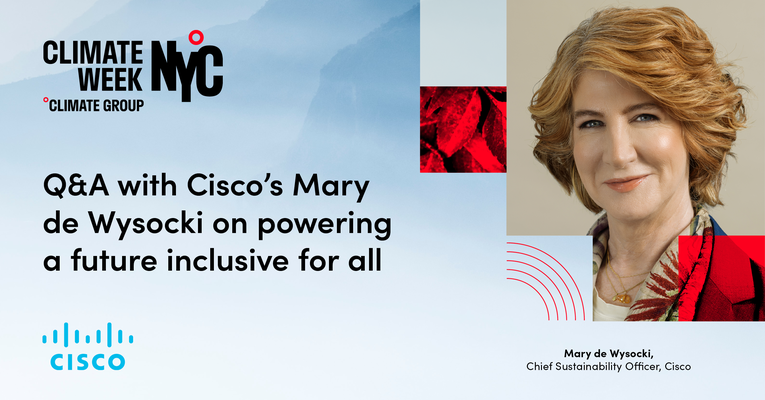Cisco’s purpose is to Power an Inclusive Future for All, but an inclusive future depends on a healthy planet. When it comes to maintaining a livable planet, not one company or organization can solve the challenge of climate change alone. Climate Week NYC gives us a chance to share our progress and best practices so we can work with others and have a more collective impact.
On Tuesday, September 19, Cisco is leading a panel discussion within the Energy and Transport Transition stream at Climate Week NYC’s The Hub Live. Our panelists will explore the topic of transforming grids globally, and the role of technology, digitalization, and collaboration on the road to renewable expansion.
How are your company’s goals reflecting the level of action science is saying is needed?
The science tells us that to hold global warming to 1.5 degrees Celsius compared to pre-industrial times requires increased ambition and adoption of robust emissions reduction targets. In 2021, we set our most ambitious and important goal yet: to reach net zero across our value chain by 2040 by prioritizing deep emissions reductions across all scopes of emissions. Our net-zero goal covers Cisco's full carbon footprint, including the use of our products, our operations, and our supply chain. In 2022, our net-zero goal was validated by the Science Based Targets initiative (SBTi) under its Net-Zero Standard. SBTi defines best practices in science-based target setting aligned with the need to halve global emissions before 2030 and achieve net zero before 2050. Cisco is one of the first technology hardware and equipment companies to have its net-zero goal validated under the SBTi Net-Zero Standard.
How do you ensure your company’s reporting remains transparent and accountable?
Cisco has a long history of reporting on sustainability, and we want to continue to share our progress in an authentic and transparent way. To remain transparent, we publish an annual Purpose Report and maintain an environmental, social, and governance (ESG) Reporting Hub. The report describes our commitments, goals, progress, and impact for the ESG topics that are important to our stakeholders from our most recent fiscal year. The ESG Reporting Hub includes in-depth information and historical data on all reporting topics. Cisco is trusted in the IT space, and we strive to maintain that trust in our reporting. If we make a claim about a product or solution’s potential to reduce energy consumption or emissions or provide other benefits, we have data to back that up. We give our customers the most accurate information possible so they can make the best decisions for their businesses.
Given the need to bring down emissions to at least 50% by 2030, what actions are you taking now to cut your carbon footprint?
The use of Cisco’s products makes up the majority of our emissions footprint. Our engineers have made great progress in power efficiency and circular design, and we’re also seeing customers ask for more capabilities and greater bandwidth that increase power demands. That means we must think even bigger, exploring ways to accelerate renewable energy adoption and the greening of the grid. Our second-largest source of emissions is our supply chain. Cisco has set a goal that 80% of our component, manufacturing and logistics suppliers (by spend) will set public GHG emissions reductions targets by 2025, and we regularly share our learnings with them. As of our fiscal year 2022, 78% of our suppliers have set public emission reduction targets. Increasing our use of renewable electricity is also a fundamental part of our strategy. In fiscal 2022, 89 percent of our global electricity came from renewable energy sources, including 100 percent in the United States, Canada, and several European countries.
What role does innovation play in your company's efforts to address climate change?
Our engineering teams are incorporating Circular Design Principles such as prioritizing materials with recycled content; designing products for resource efficiency; and facilitating repair, remanufacturing, and recycling to extend product life. We have a goal for 100% of new Cisco products and packaging to incorporate Circular Design Principles by fiscal year 2025. For example, our Unified Computing System (UCS) servers are built with modular, easily removable components, and the latest generation of UCS servers also features plastic parts made of post-consumer recycled resin. The Cisco Foundation is also investing US$100 million over 10 years in innovative climate solutions, including early-stage decarbonization technology and nature-based solutions. These investments send a signal to other investors about what we value and where we believe the future is headed. One investment I’m particularly proud of is Vibrant Planet’s Data Commons platform that helps to better manage local land use and plan for risks like wildfires.
